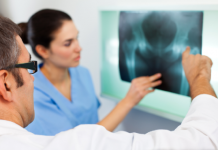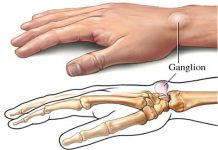DESCRIPTION
It is the name given to the foot wounds developing on the diabetic patients.
WHAT IS THE CAUSE?
DiyabetesMellitus (DM) is a chronic disease occuring when the pancreas cannot produce enough insulin or when the body cannot effectively use the produced insulin. In such diseases, blood glucose lever increases (hyperglycemia) and all the tissues like the blood vessels and nerves are chronically and progressively damaged. The patients develop occlusive vessel disease (angiopathy), kidney function disorder (nephropathy), nevre damage (neuropathy) and visual disorder (retinopathy). These complications occur in the long period and progress slowly. Nevre damage and occlusive vessel disease occuring as the complications of diabetics cause to the wounds on the feet. Neuropathy (nevre damage) is the leading cause to diabetic foot wound. In most of the patients, it is observed that an unnoticed reason like hitting, striking, sticking, burning etc causes the wound. The wounds are generally not noticed at the early period due to loss of sense which causes to progressive tissue injury (figure 1).
Angiopathy (occlusive vessel disease) has less effect on the occurence of foot wounds. Since the blood stream decreases in the patients’ feet, the main materials, oxygen and antibiotics are constricted to reach to the wounded area. That’s why the possibility of healing on the wounded area gets more difficult. The bacteria (infection) occuring on the wound extends to the deep tissue quickly and causes large necrosis. This process is called gangrene. This quickly developing gangrene may cause the patient to lose his foot or even life (figure 2).
Chronic foot infection occuring on the diabetic patients are commonly seen infections which are difficult to treat. Today, despite the advanced technology regarding the prevention, diagnosis and care of diabetic-caused wounds, there are still many unsolved problems.
HOW TO DIAGNOSE?
The diagnosis of diabetic foot is first established with the examination (seeing the wounds). It is important to make healthy classification of the wound. Today, the most commonly used system is Wagner classification (Table 1).
Table 1. Wagner Classification
Degree-Specifications
0 osteophyte and/or callus on the healthy skin (risk for ulseration)
ISupercifial ulcer on the skin
IIDeep ulcer extending up to the tendon, bone, ligament and joint
IIIDeep ulcer extending up to the abscess and/or osteitis
IVInfarction on the forefoot covering the finger and/or metacarpus
VSpread, serios gangrenous retention on the foot requiring amputation
The clinical symptoms and findings of the diabetic foot may be diagnosed with two different tables:
1) The infections nonthreatining for the leg are superficial and do not exceed two cm within cellulitis limits. Even if these patients have ulcer, the wound does not extend to the sub tissues and bone-joint retention findings are not expected (figure 3).
2) The infections threatining the leg have a cellulitis area of more than 2 cm. The ulcer is deep and the infection has extended to the bone and joint tissue. Whether or not having the gagngrene, almost each case schemic (decrease in tissue bloodstream) findings (figure 4). The patient may have fever in accordance with the deepness of the ukcer, the existence of abscess and bacteria in the blood.
Local infection findings are the increase in temperature, redness, swelling and discharge around the wound (figure 4). The patient has a little or no pain or sensitivity due to neuropathy (nevre damage). In the diabetic-caused infections, the prognosis of the leg is determined by the anatomic location of the wound. In the infections closer to the body (metacarpus, heel or ankle), the prognosis is worse and the mortality rate is higher (figure 5). It should be taken into consideration that the gangrene on the dianetic foot is caused by the infectiion or ischemia.
Many different test can be used to diagnose the infection. Whole blood count and routine biochemical tests have almost no contribution to the diagnosis. Even in the serious infections threatinig the leg, the increase of the white blood cell count in the blood (leucocytosis) is only observed half of the cases. erythrocyte sedimentation rate (ESR) is generally high. The rate of detecting development in the blood cultures is around 10-15%.
Tissue culture is still a controversial issue. It is certainly clear that the superficial samples are insufficient to determine the factor especially in the chronic wounds. The cultures can be taken either during debridement (the cleansing of the infarct) or directly from the ulcer base. In the examination called gram staining, detection of the gram-positive clubs are significant in terms of the diagnosis of dangerous infections (clostridial infections = microorganism creating gas while developig). Gram staining is is directive for the early diagnosis and treatment of these rapidly progressing infections.
Radiological examinations may be beneficial in the evaluation of the woubd area and diagnosis of the bone infection. The air spaces that are radiologicall observed within the soft tissue may be caused by open ulcers, the devridements performed or the microorganism creating gases while developing. The gas is mainly composed by non clostridial anaerobes, coliforms, streptococcus and rarely by clostridiums. Since the formation of the gas can be caused by many factors, it should never be valid reason for amputation (cut of the organ) only by itself.
Osteomyelitis raleted radiolgoical findings startes 10-20 days after the infection. So, in the early diagnosis of the osteomyelitis, 3-4 phased and marked leucocyte scans and MR imagings are more beneficial. There may be false positive rate in the results taken by the MR; however the most important advantage of this method is its help to detect the dimensions of the soft tissue retention and the limits of the debridement accordingly.
The sufficiency of bloodstream should be controlled for each patient having diabetic foot infection. Arterial insufficiency is seen in 66% of the non-healing ulcer and 46% of the amputations.
TREATMENT
When the patient is first seen, the most correct approach shall be to examine all the systems and to generally evaluate the patient in regards to the other complications (retinopathy, nephropathy etc.). After the foot examination, the classification should be made in accordance with the damage and the relevant treatment should be arranged. The purpose at the first stage is to avoid the complications and infections and to prevent the amputation if any infection is developed. The treatment includes regulating the blood glucose, surgical debridement if necessary, discharging the abscess and antibiotic regime.
The treatment of the diabetic foot wounds includes three main factors:
1. Local wound care,
2. Offloading (avoiding trauma and load)
3. Antibiotic treatment.
While two weeks of antibiotic treatment is enough for secondary infections which are non threatining for the leg; wider range of iv antibiotics is required for the patients with serious infections threatining the leg or who have already used antibiotic treatment before.
SURGICAL TREATMENT
Regardless of the clinical level, orthopedician consultation is required for the diabetic foot patients. With the surgical intervention to be performed, both the infarct around the wound can be removed and deep tissue and bone biopsies can be taken. It is difficult to differentiate the soft tissue infection from the edema caused by the bone infection in such diseases. Besides, the differentiation between the osteoarthropathy developing on the loss of sense and the bone infection has critical importance. While long termed antibiotic treatment and surgery is necessary for the bone infection, conservative approach is recommended for the latter. Moreover, the rate of amputation in the osteomyelitis developing on the diabetic base is much more higher than the non-diabetic patient group. Thus, clinical opinion is not sufficient for the patients having diabetic and foot ulcer.
WHAT IS THE PROCESS OF THE TREATMENT?
The appropriate treatment of the diabetic foot infections is still unclear. The treatment periof for the soft tissue infections should be at least 10-12 days. The treatment may be given either iv or orally as required by the severeness of the infection. This period shall be enough for the infections that are non-threatinig fort he leg. In case of osteomyelitis, this treatmenr periof shall be prolonged. If the bone infarct is not completely removed, the treatment is recommended to be prolonged up to 6-12 weeks. If no clinical healing is observed on the fifth day of the treatment, it generally indicates the failure of the treatment. The most common reasons of this failure are undefined abscess or resistant factors. In such a case, the overlooked infection can be researched with CT, MR, ultrasonograpy or indiumleucocyte scan tesy or the antibiotic treatment can be changed.
Amputation should be performed in acute, life threatining infections and when the wound integrity is ruined (figure 6). Amputation and rehabilitation is a life saving and life quality increasing intervention for the patients with their local and systemic findings are not healing an deven getting worse despite the long termed antibiotic treatment.
FOOT CARE
Foot care has an important and effective role on the prevention of foot wounds. The increase on the consciousness and knowledge levels of diabetic patients on their diseases will provide active contribution to the daily foot care.
1. It is important to choose the appropriate shoes in order to prevent the formation of new wounds or the recurrence of the healed wounds on the foot.
2. Different shoe brands may have different shoe sizes. Shoes should not be sold without first trying as the size can change.
3. New bought should not be worn more than two hours.
4. As the feet get swollen in the evenings, shoes should be bought in the evenings.
5. Cotton thin socks should be worn with the shoes and the socks should be changed every day.
6. The special shoes designed for high risk foot wounds are to prevent the wounds; they should not be expected to be effective in the wound treatment.
7. Foot care should not be disregarded even if progtective shoes are worn.
8. Shoes and iner liners should be controlled every morning by hand in case of foreing object like Stones, nails or pricks.
9. After the shoes are taken off, the foot and interdigitals should be controlled carefully to find out if there is any redness which is a sign of pinch.
10. The feet (especially interdigitals) should be washed, dried and rubbed with moustrizer every day.
11. The temperature of the washing water should be controlled by touching with elbow and the water should not be too hot.
12. You should not walk on bare foot either in or outside the house.
13. The toenails should be cut straight; the callus should not be removed by scissors or any other sharp object in the house.
12. The patients having loss of sense should not make exercises like running or long walks.
.












